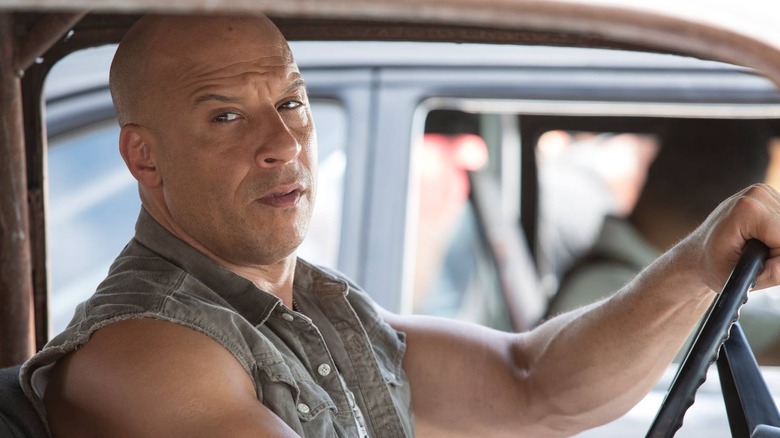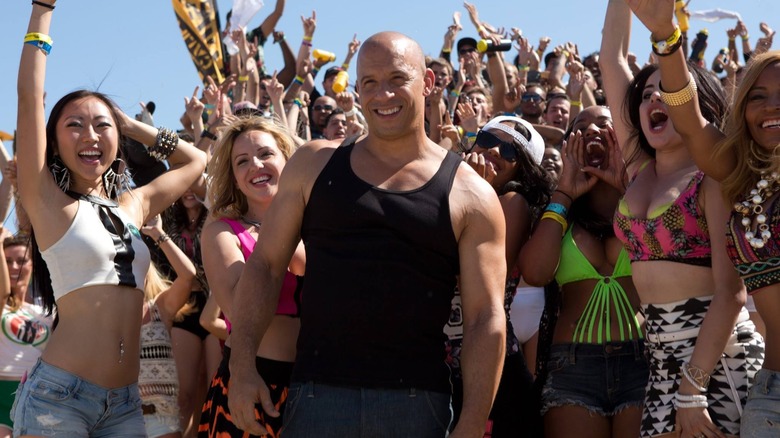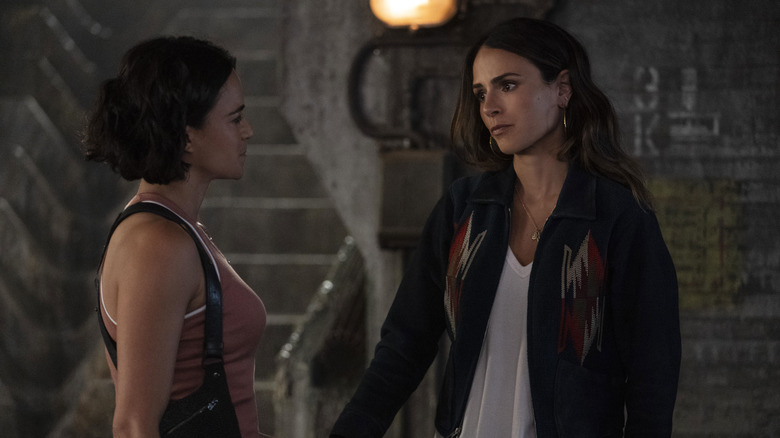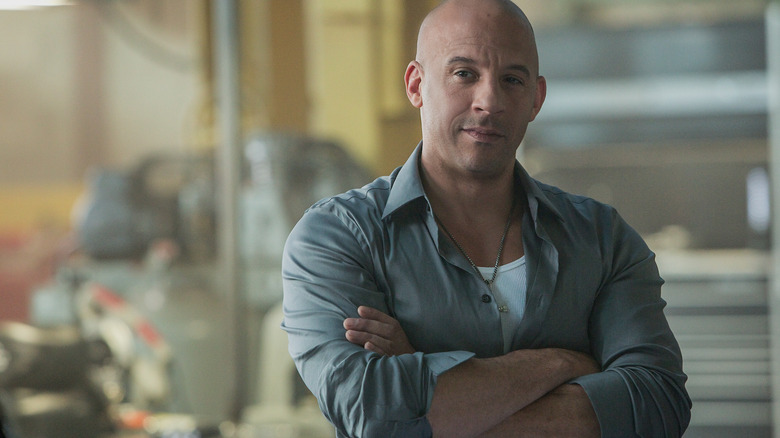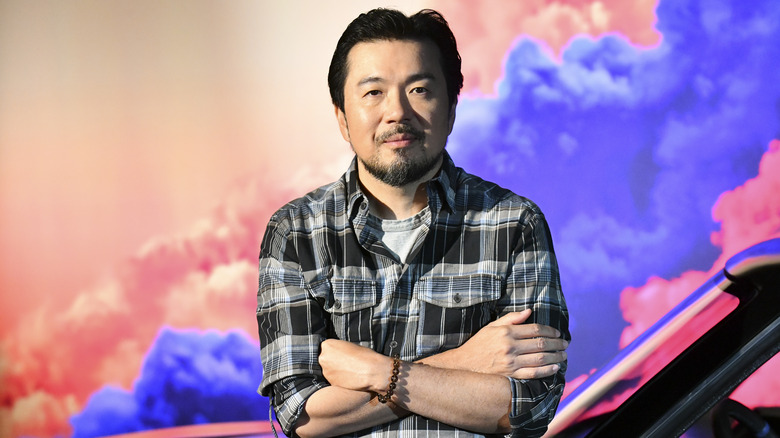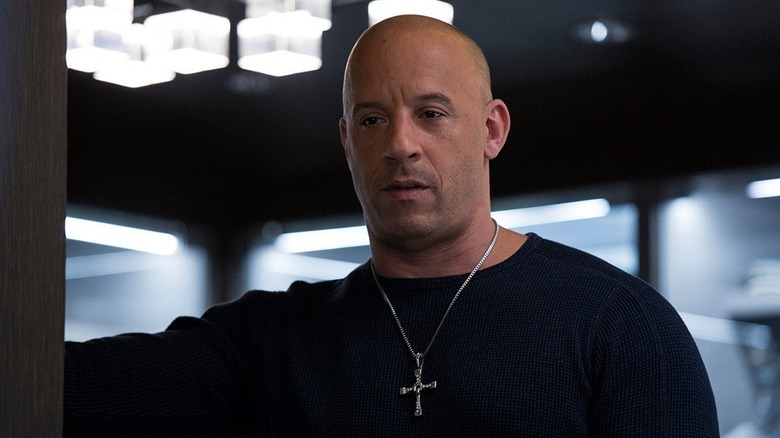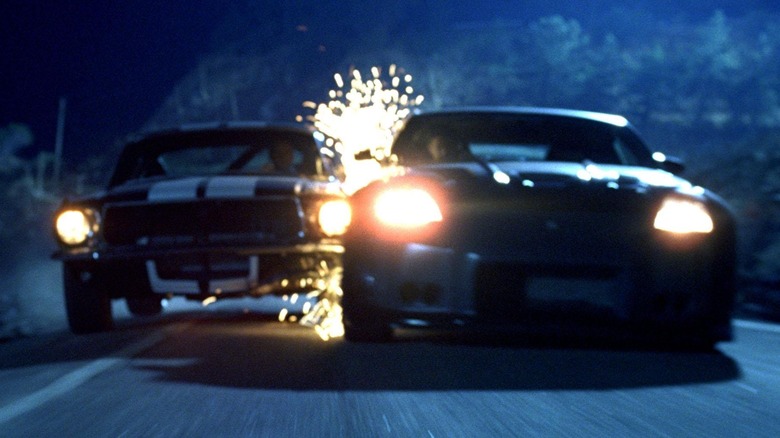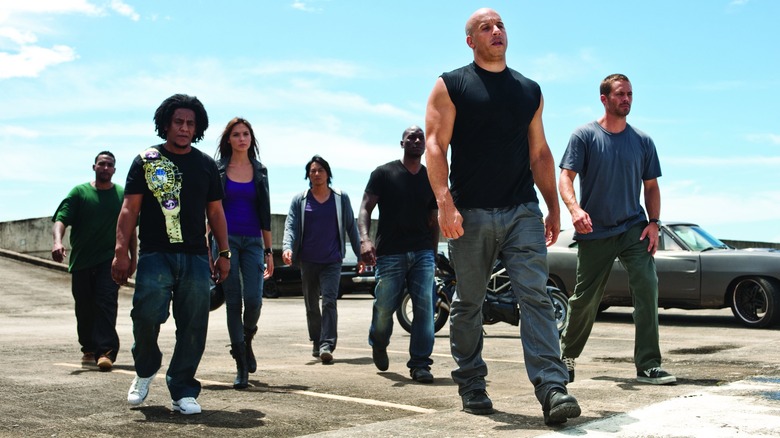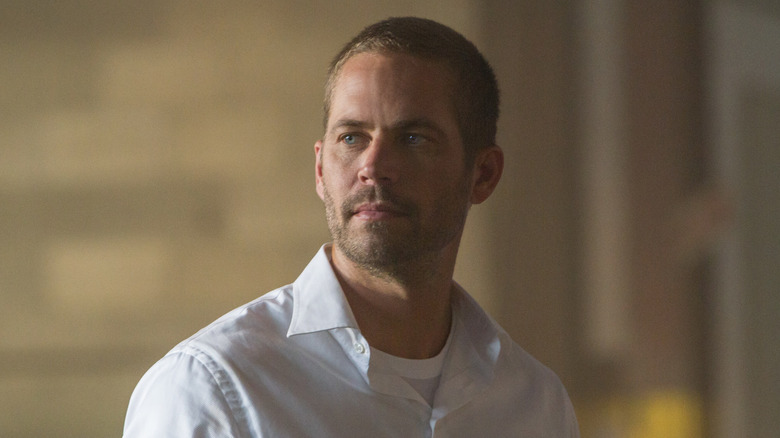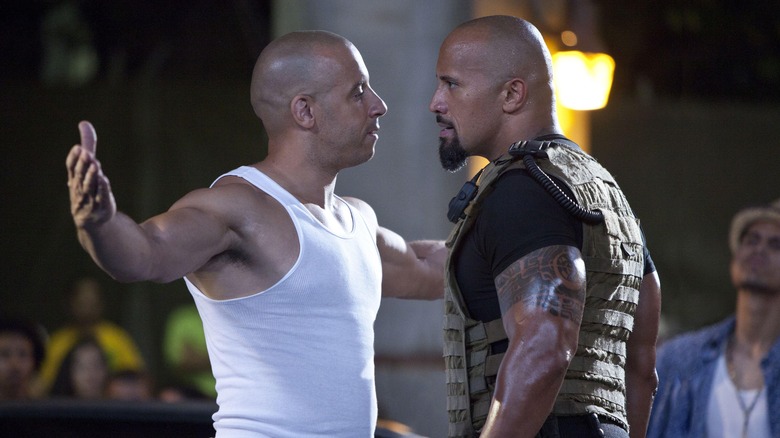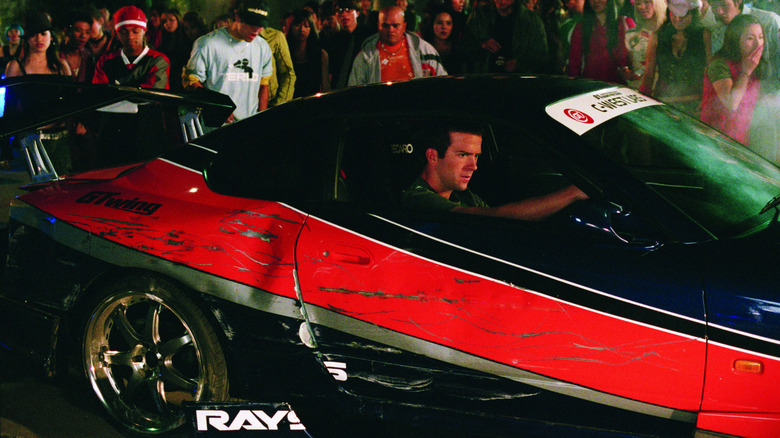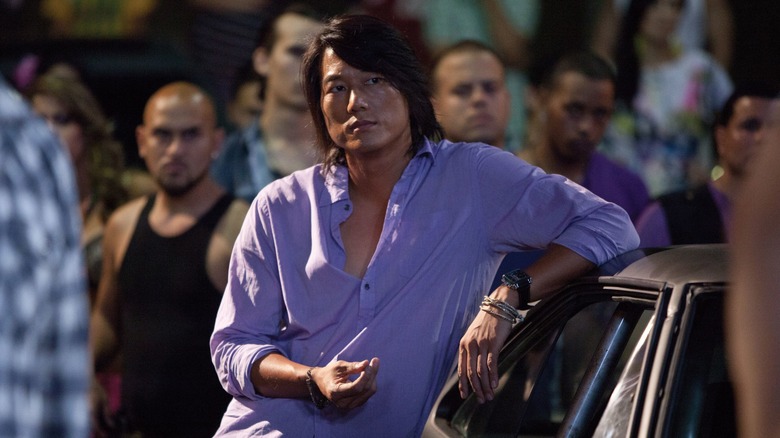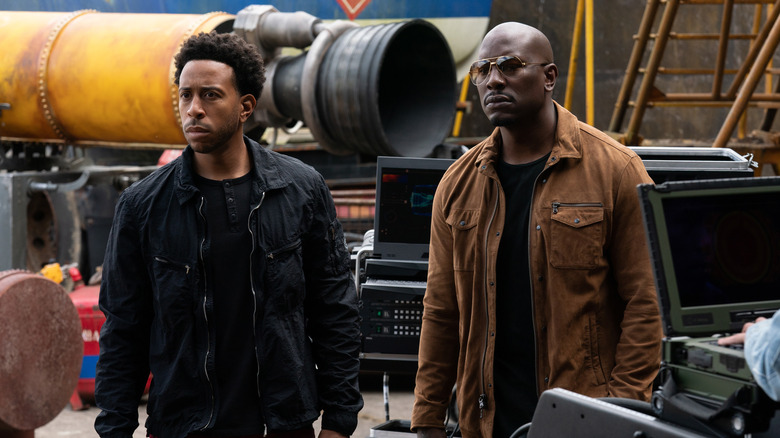The Untold Truth Of The Fast & Furious Franchise
Who would've thought that a silly little movie about Los Angeles street racers would spawn one of the biggest movie franchises of all time? Unlike contemporary competitors like "Star Wars" or the MCU, "Fast & Furious" was never meant to become a multimedia juggernaut. It got there in stages — a couple of mostly unrelated movies at first, a little spin-off, a few big heist films, and eventually, somehow, the titanic, globetrotting spy thriller saga fans know today.
That messy lineage is part of what makes "Fast & Furious" so interesting. There are so many points in the series' history when it could have gone under or been driven into the ground, only to be saved by luck and some fortunate studio decisions. And of course, with more than 20 years of history, there have been plenty of departures, late changes, and even tragedies that have shaped the story of Dom Toretto (Vin Diesel).
Much of that history is common knowledge for fans. We're not here to talk about how Vin Diesel and Dwayne Johnson's feud cast the latter out of "F9: The Fast Saga," or how the online #JusticeForHan fan movement brought Sung Kang's beloved character back from the dead, or how the first "Fast & Furious" film was actually based on a piece of investigative journalism. You already know all that. Instead, let's dive a little deeper into the "Fast & Furious" franchise and explore some of its lesser-known secrets.
The iconic title was stolen from another movie
At this point, "Fast & Furious" is almost as iconic of a title as "James Bond," "Godzilla," or "Jurassic Park." The moniker has become so famous (and been twisted in so many bizarre ways by the movies' baffling naming conventions) that it's hard to imagine it being associated with anything else. And yet, long ago, it was.
Speaking with Entertainment Weekly in 2021, longtime series producer Neal Moritz revealed that the first movie went through many potential names before the producers settled on the right one. That list included "Racer X," the name of the Vibe article on which the film was loosely based, and "Race Wars," which is the name of the racing event the characters attend in the movie. "Redline" and "Street Wars" were also thrown around as possible titles. "They were all cheesy," Moritz said. Eventually, the right name came via a much older movie.
"I went to watch a documentary on [producer] Roger Corman, who I've known since I was a kid," Moritz said. "And there was a little section on a movie he'd made called 'The Fast and the Furious.' I thought, 'That's the title of this movie!'" Corman's film, released in 1954, is quite different from 2001's "The Fast and the Furious," but there are a lot of similarities. Both tell stories about two-bit criminals on the run, and both end with someone begrudgingly handing over keys to those criminals to help them escape. According to Moritz, Corman was paid in Universal stock footage for the use of the title.
Some stars couldn't drive at all in the beginning
If there's one thing every character in "Fast & Furious" has in common, it's their preternatural ability behind the wheel of a car. Air-dropping out of a cargo plane? Do it in a car. Holding onto a top-secret piece of military technology? Hide it in a car. Trying to get to outer space to manually dismantle a satellite? Why not take a Pontiac Fiero? The franchise has succeeded on a basic model of, "Whatever the Avengers did, do that but in cars." Therefore, every member of the cast must have been extremely comfortable in the driver's seat. Right?
Wrong. As reported by Insider, neither Jordana Brewster nor Michelle Rodriguez had a driver's license when they were cast in the original movie. Brewster was particularly new to the notion of handling a car, as she grew up in New York City, where driving was never a necessity. Thankfully, director Rob Cohen helped get her up to speed, so to speak.
"I was this preppy Upper East Side girl," Brewster told Insider. "Cohen was like, you need to drop all of that and you need to just be in your body." The actress, who plays Mia Toretto in the films, said, "If I didn't get my license I wasn't going to be able to get insured for the movie." The whole cast conducted special driving training in Las Vegas prior to shooting, so without passing her driving test (on the first try, mind you), Brewster may not have kept the part. She did, though, proving herself a Toretto through and through.
Vin Diesel bet big on a different franchise first
Vin Diesel has developed something of a reputation for talking up the "mythology" of the "Fast & Furious" franchise. Heck, he's even compared the movies to "The Lord of the Rings." Diesel has served as a producer on the series for years, allowing him far more narrative and creative control than most stars ever have in their biggest movies. But at the beginning, it took the actor quite a while to really buy into the franchise.
As a matter of fact, Diesel was far more interested in another big action series first: "The Chronicles of Riddick." He starred in "Pitch Black" in 2000, over a year before "The Fast and the Furious" was released in 2001. And when it came time to choose between the two sequels, Diesel picked "Riddick." "I remember turning down '2 Fast 2 Furious' and a whole lot of money," Diesel told IGN in 2013. "And instead of doing that movie for the year, I took a WGA writer's polish deal for "Chronicles" for $50,000." According to Diesel, the "2 Fast" deal would have paid upward of $20 million. Clearly, "Riddick" was his priority.
Ultimately, his love of the sci-fi franchise is what brought him back to "F&F" as well. As "Pitch Black" director David Twohy told HuffPost in 2013, Diesel agreed to do a cameo at the end of "The Fast and the Furious: Tokyo Drift" in exchange for Universal giving him the "Riddick" rights. The rest is history.
Justin Lin's entrance to the franchise with Tokyo Drift was pretty rocky
For the third film in the "Fast & Furious" franchise, Universal went with a young up-and-coming director: Justin Lin. Lin had already made a name for himself with the 2002 drama "Better Luck Tomorrow," which follows a group of Asian American high school students who get wrapped up in a shady world of crime. Lin wound up sticking with the series for four films and came back for "F9" in 2021, leading the franchise into its modern incarnation as an international pop culture sensation. But it wasn't always smooth sailing for his first "Fast & Furious" movie.
In a 2006 interview with SFGATE, Lin said that the first draft of the "Tokyo Drift" script was "offensive and dated" and that he demanded major changes if the studio wanted him involved. "To begin with, I'd get rid of all the gongs and temples and Buddhas and the visual gags about how the white guy is a foot taller than all the Asians," the director told Stacey Snider, the head of Universal Pictures at the time.
While many of these changes were implemented, grappling with Universal was still a "constant challenge," according to Lin. His desire to cast an Asian American actor in the leading role was rebuffed, though he said he was happy with Lucas Black being the final choice. Lin was able to bring in his "Better Luck Tomorrow" collaborator Sung Kang to play Han Lue in the movie — a conspicuously similar character to his role in Lin's earlier film.
Vin Diesel saved Fast & Furious from going direct-to-DVD
After three largely unrelated installments, "Fast & Furious" started to run out of gas. "Tokyo Drift" made just $157 million at the box office — the lowest in the entire franchise to this day and a marked drop from its two predecessors. Given the subject matter of the films and the studio's habit of replacing the cast in every entry, Universal considered downgrading them to true B-movie territory. "The talk internally was that the franchise was played out," then-co-president of production for Universal Pictures Jeffrey Kirschenbaum told TheWrap in 2013. "At that point we were weighing whether to go straight to video or not for future sequels."
But then, something magical happened. Vin Diesel returned for an unpaid "Tokyo Drift" cameo in exchange for the "Chronicles of Riddick" rights, and the preview audiences went nuts the second he showed up on the screen. According to Kirschenbaum, Diesel's popularity convinced Universal to try one more theatrical release with him once again in the driver's seat.
To that end, the studio brought back most of the first film's cast and positioned it as a soft reboot, even titling it simply, "Fast & Furious." The fourth film in the franchise grossed nearly $360 million worldwide, smashing the profits of all three previous films and setting the stage for the franchise's modern success. Without Diesel's brief "Tokyo" cameo, the series could have just as easily been relegated to Blockbuster Video and Walmart checkout aisles.
Weird cars, but real cars
Over the years, "Fast & Furious" has played host to some truly wild vehicular creations. And while some of them are more fiction than fact (looking at you, Space Fiero), you might be surprised to learn just how many of the series' iconic cars were actually constructed and how they did it.
The iconic "Driftstang" from "Tokyo Drift" was actually played by six or seven different cars, which really did have Nissan GT-R RB26 engines swapped into them, according to consultant Craig Lieberman. "Furious 7" wasn't able to use real Lykan HyperSports for the famous skyscraper jump stunt, as only seven were ever made, but special movie versions were built in collaboration with the studio.
The franchise has also helped bring some lesser-known models back into vogue. Those include the 1970 Ford Escort that Brian (Paul Walker) drives in "Fast & Furious 6" and the 1971 Jensen Interceptor piloted by Letty (Michelle Rodriguez) in the same movie. There's also the now-iconic orange fourth-generation Toyota Supra that Brian builds and races in the first movie. According to car consultant Craig Lieberman, eight different Supras were used during filming, for a total cost of $111,674.33. Today, a single fourth-gen Supra might run you close to that price on its own.
Hidden cameos
We all know the more notable cameos in "Fast & Furious." From early on, the franchise has been a magnet for hip-hop artists, with Ja Rule appearing in "2 Fast 2 Furious" (although not in as big of a role as was offered), Ludacris popping up in that same film and later becoming a member of the main cast, Bow Wow featuring in "Tokyo Drift," and Cardi B making a cameo in "F9: The Fast Saga." But there are some other, more subtle cameos that you might not know about.
Model and TV personality Chrissy Teigen appears in "The Fast and the Furious: Tokyo Drift," but not in the way you might expect. "I sat on the floor with 200 people in a parking garage in downtown la [sic]," Teigen tweeted in 2020. She continued, "They pulled me to be "girl getting out of car"'and the shot ended up cutting off at my face as they panned up my body." "Tokyo Drift" also featured a number of real-life drift racers, who both consulted and acted as stunt drivers. If you don't follow the international motorsports scene, names like Nobushige Kumakubo and Keiichi Tsuchiya (the actual "Drift King") might not mean much. But in the car world, they're celebrities too.
Director Justin Lin's son has also been featured in multiple films, popping up briefly in both "Fast Five" and "Fast & Furious 6." And while he doesn't appear onscreen, Chris Hemsworth apparently spent a good bit of time around the set of "Fast Five," as his wife, Elsa Pataky, plays Elena Neves in the film.
How Paul Walker's death changed the story
Paul Walker's tragic death understandably led to some big changes in "Furious 7," which became a proper tribute to his life and career. Originally, the film was meant to have what writer Chris Morgan described to Collider as a "happier" ending. "The original ending, if I remember correctly, was our guys end up solving the problem and then kind of becoming — again, going more outlaw," he said. "It was sort of a happier ending that kind of ends with the insinuation that they were gonna go off onto this heist or this job."
To write out Walker's character while also paying homage to him, as the actor died during production, a different ending was scripted. Brian fully walks away from the life of manic thievery he's known, accepting his family as his new, complete purpose. It's bittersweet, as Morgan has admitted, but it's also what helps the film transcend the silly action movie trappings of the franchise.
"Part of Paul's legacy lives through every frame that we shoot," Vin Diesel said at CinemaCon 2017 via Time magazine, just weeks before "The Fate of the Furious" premiered. "You are reminded of this angel that was so integral to this concept of brotherhood for our millennium. There's something beautiful about that. There's something celebratory about that." To be sure, Walker's legacy has been kept alive through the series, which has done well to keep his character present in the negative space, rather than through recasting.
Chaos behind the camera
The "Fast & Furious" franchise has made chaos one of its calling cards, with bigger, bolder, more ludicrous stunts popping off in each successive entry. But the business behind the camera has at times been similarly chaotic — albeit with fewer exploding cars.
The minds behind the series have swapped around a number of times over the years, with Justin Lin departing after "Fast & Furious 6" only to return for "F9: The Fast Saga." Lin was meant to direct "Fast X" as well, but he left just days into filming. According to "The Hollywood Reporter," Lin had grown frustrated with the constant changes being made to the script and was butting heads with Vin Diesel over creative decisions. An official statement from Universal claimed that Lin's issues "were with the studio, not with fellow producers, cast or crew."
It's not the first time someone behind the camera has taken umbrage with Universal's handling of things. In 2018, longtime series producer Neal Moritz filed a breach-of-contract lawsuit against the studio for allegedly ousting him from "Hobbs & Shaw," the Dwayne Johnson and Jason Statham "Fast & Furious" spin-off. In 2020, Moritz settled with Universal and returned to the franchise, once again serving as a producer on "F9."
Someone once went to jail for the good of the franchise
Folks like Justin Lin and Neal Moritz may have had their share of squabbles with Universal over "Fast & Furious," but neither has ever had to do hard time for the sake of the franchise. But during the production of "Tokyo Drift," things got a little more legally dicey. It was difficult to get official permission to shoot, which led to some less-than-legal tactics.
"When we went to shoot in Tokyo it's a very different culture," Lin told Digital Spy in 2009. "They don't give out film permits." The crew wound up shooting some material without getting a proper go-ahead from local authorities, and the studio made sure someone inessential was around to take the fall.
"I wanted to shoot in Shibuya, which is the most crowded place in Tokyo," Lin told Digital Spy. "They shut us down, I'd gotten all my shots, but I didn't know they were going to arrest me. Another guy stepped up and said, 'I'm the director.' I found out that it was his job to take the fall for me. He went to jail for the night, and I'm forever grateful." Sometimes, when you're making movies about illegal street racing, you have to embrace some under-the-counter tactics yourself.
Roger Ebert was a fan
Film critics: They're notoriously fickle and difficult to please. That's doubly true when it comes to the blockbuster territory, where CG effects and focus-tested storylines tend to triumph over pesky things like emotional meaning, themes, and art. The late Roger Ebert may still be the most famous American film critic, and he never shied away from ripping movies apart when they failed to impress him. And yet, even during the generally panned early days of the "Fast & Furious" franchise, Ebert was (almost) always complimentary of the films.
The legendary writer gave favorable ratings of three stars out of four to all but one of the five movies he reviewed before his death in 2013. "Fast & Furious" earned a dismal one-and-a-half star rating, but he came back to the side of the franchise in "Fast Five." Of Justin Lin's directorial chops, Ebert was particularly complimentary. "Unlike a certain other maker of Crash-Crash-Bang-Bangs, whose name I trust you to summon effortlessly, he devotes attention to a storyline that devises ingenious new things to do instead of obsessively blowing up things," the critic wrote. Take that, Michael Bay.
Stunt inspirations
A big reason why "Fast & Furious" has managed to stay atop Blockbuster Mountain for so long is that it always manages to come up with new, clever twists on the action set pieces you've seen before. Every installment promises something different, be it super magnets, nuclear submarines, or pulling a bank vault through downtown Rio behind two massive Dodge Chargers. It's no small feat delivering fresh ideas time and again, and the producers have taken inspiration from many places to ensure a consistent level of mania.
Justin Lin's own son came up with the idea for the magnet plane stunt in "F9: The Fast Saga" after being brought along to a production meeting by his director dad. "We were talking about the ravine [set-piece]," Lin told Empire in 2021, "and I said, 'Alright, so here's Roman and Tej. Jakob needs to get to the other side — how does he get there?' And Oqwe just picked it up and pitched the idea of the plane and everything."
In the earlier days, making big set pieces happen wasn't always so easy. Due to budget constraints, Lin told Collider, the production only had a day and a half to film the favela chase in "Fast Five," forcing some creative manipulations to handle a sequence that normally would have taken six days. The director has also used stunts he envisioned long before their actual debut. For instance, the shot of a car bursting through the nose of an airplane in "Fast & Furious 6" was conceived of by Lin during the production of the fourth movie. "The technology wasn't ready yet, and I couldn't find the right story to tell it in," he told the Los Angeles Times in 2013. Fortunately, he found the right moment later on.
